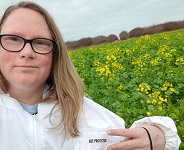Lea Hannah
Candidature
PhD Candidate
Thesis Title
Insect Pollination of Almonds
Research Project
Extra crop floral resources and honeybee health in Australian Almond Orchards
The European honeybee (Apis mellifera, L.), is the single most important managed pollinator of our pollinated food crops worldwide. The average economic value of wild and managed honeybees for pollination in Australia has been estimated at 14.2 billion AUD (2014-2015) (Karasinski, 2018). A particularly important case involves the expanding almond industry in Australia, which is 100% reliant on honeybees for cross pollination. The industry currently requires around 200,000 hives to pollinate mature orchards and it has been predicted that 300,000 honeybee hives will be required by 2021 (Feuvre, 2017). Securing ongoing pollination services is therefore essential for the almond and other pollination dependent industries in Australia.
 Honeybees are solely reliant on floral resources to supply them with adequate nutrition for maintenance and growth. Agricultural intensification has led to a natural habitat fragmentation and a reduction of available floral resources within the landscape (Simon G. Potts et al., 2010; Dolezal et al., 2019). Lack of forage and ensuing nutrition stress have been identified as major issues relating to honeybee health and immunocompetence (Brodschneider and Crailsheim, 2010; Dolezal and Toth, 2018). Improving the health of honeybees in order to improve their ability to resist abiotic and biotic stressors has been identified as a key issue for research in Australia.
Honeybees are solely reliant on floral resources to supply them with adequate nutrition for maintenance and growth. Agricultural intensification has led to a natural habitat fragmentation and a reduction of available floral resources within the landscape (Simon G. Potts et al., 2010; Dolezal et al., 2019). Lack of forage and ensuing nutrition stress have been identified as major issues relating to honeybee health and immunocompetence (Brodschneider and Crailsheim, 2010; Dolezal and Toth, 2018). Improving the health of honeybees in order to improve their ability to resist abiotic and biotic stressors has been identified as a key issue for research in Australia.
The main aim of this research is to quantify the potential benefits of extra crop floral resources (ECFR) on honeybee health within the Australian Almond growing context. Twenty-five hectares of floral resources will be sown (headlands and in-row) across four commercial almond orchards in the Sunraysia district of Victoria. The seed mix includes canola (Brassica napus), white mustard (Sinapsis alba), SMART radish (Raphinus sativus), Presto vetch (Vicia benghalensis) and White Cloud crimson clover (Trifolium incarnatum). My research will focus on quantifying the use ECFR by honeybees and how increased floral diversity (including access to native vegetation) translates into improved honeybee health and pathogens resistance.
I will follow four main courses of investigation:
- Utilisation of floral resources by honeybees;
- Influence of ECFRs on hive strength and activity;
- Effects of ECFR on resistance to the fungal pathogen Nosema sp. and
- Honeybee behaviour in almond orchards. The outcomes of this research will lead towards more sustainable agricultural practices, increases in on-farm biodiversity with long-term benefits for the almond industry, pollinator security and honeybee health.
Supervisors
Professor James Cook, Professor Sally Power, Professor Markus Riegler, Dr Laura Brettell
Publications
Quarrell SR, Weinstein AM, Hannah L, Bonavia N, del Borrello O, Flematti GR, Bohman B, (2023) 'Critical Pollination Chemistry: Specific Sesquiterpene Floral Volatiles in Carrot Inhibit Honey Bee Feeding', Journal of Agricultural and Food Chemistry, vol.71, no.43, pp 16079-16089
Garcia JE, Hannah L, Shrestha M, Burd M, Dyer AG, (2022) 'Fly pollination drives convergence of flower coloration', New Phytologist, vol.233, no.1, pp 52-61
Hannah L, Dyer AG, Garcia JE, Dorin A, Burd,M, (2019) 'Psychophysics of the hoverfly: categorical or continuous color discrimination? Curr. Zool, vol.65, pp 483–492
Posters
Hannah, L. (2018). Poster Presentation: International Conference of Neuroethology
VG08179 HAL (2011). Development of native bees as pollinators of vegetable seed crops
MT08081 HAL (2011). Improving the reliability of vegetable seed production
References
- Brodschneider, R. and Crailsheim, K. (2010) ‘Nutrition and health in honey bees’, Apidologie, 41(3), pp. 278–294. doi:10.1051/apido/2010012.
- Dolezal, A. G. and Toth, A. L. (2018) ‘Feedbacks between nutrition and disease in honey bee health’, Current Opinion in Insect Science. Elsevier Inc., 26, pp. 114–119. doi: 10.1016/j.cois.2018.02.006.
- Dolezal, A. G. et al. (2019) ‘Native habitat mitigates feast–famine conditions faced by honey bees in an agricultural landscape’, Proceedings of the National Academy of Sciences. National Academy of Sciences. doi: 10.1073/PNAS.1912801116.
- Feuvre, D. Le (2017) ‘Australasian Agribusiness Perspectives 2017, Volume 20, Paper 11 ISSN: 2209-6612 Honeybee Pollination Services for the Australian Almond Industry’, 20, pp. 194–205.
- Karasinski J. (2018) ‘The Economic Valuation of Australian Managed and Wild Honey Bee Pollinators in 2014-2015’, pp. 1–37. Available at: www.aussiepollination.com.au/pdf/Karasinski JM 2018 The Economic Valuation of Aust Managed and Wild Honey Bee Pollinators in 2014-2015.pdf.
- Potts, Simon G et al. (2010) ‘Declines of managed honey bees and beekeepers in Europe’, Journal of Apicultural Research, 49(1), pp. 15–22. doi: 10.3896/IBRA.1.49.1.02.
- Potts, Simon G. et al. (2010) ‘Global pollinator declines: Trends, impacts and drivers’, Trends in Ecology and Evolution. Elsevier Ltd, 25(6), pp. 345–353. doi: 10.1016/j.tree.2010.01.007.